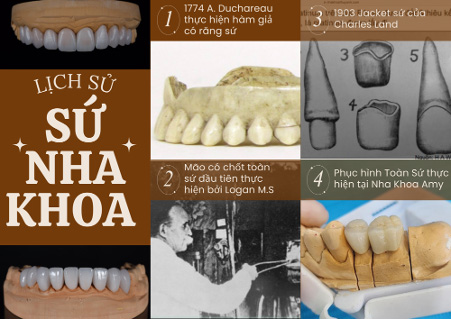- vi
- EN
08:11 | 17/09/2024
Over the years, dental ceramic also known as porcelain has played an important role in meeting the requirements of tooth replacement and especially beauty requirements. It is a very attractive material because of its biocompatibility, long-term stability, chemical resistance, wear resistance and ability to specific shapes. The interaction between light and porcelain simulates tooth color better than any other materials, which is the main reason for its use in dentistry. Besides, they require expensive equipment and highly trained lab technicians.

Amy Dental Care will provide an overview of the history of ceramic materials used in dentistry.
Ceramics is considered a milestone in the New Stone Age, this is one of the earliest materials used in human history, from the Stone Age, over 20,000 years ago, and is still popular and developed today.
During the development process, scientists encountered many difficulties on the way to bring “ceramics” into the mouth as dentures. In the 17th century, dentures were often made from dead people’s teeth, which would absorb saliva and turn yellow quickly. In addition, using animal teeth such as ivory and hippopotamus teeth made the teeth porous, expensive and difficult to find.
In 1774, A. Duchateau found out that his dentures were yellow and smelly. He set out to make the first dentures with ceramic, using enameled ceramic tools. The effect was smooth, colorless, wear-resistant dentures but easily chipped and had an unnatural white color, announced at the Academy of Surgery in 1776. This was an idea of historical significance.
1778, N.D. De Chemant published his thesis “A Dissertation on Artificial Teeth” describing the production of ceramic teeth from mineral paste. This was a breakthrough achievement when the first ideas for ceramic teeth were born. Ceramic dentures had the advantages of being shiny and aesthetic, but were difficult to chew, and were only intended for patients with complete tooth loss.
In 1884, American M.L. Logan was granted a patent for a crown with an all-ceramic pin.
Charles Land introduced the first porcelain crown in 1903. By applying porcelain powder to a platinum leaf covering the tooth stump and then firing it, he created a layer that covered the entire tooth like a cap, which he called “Jacket”. These porcelain crowns had excellent aesthetics, but low flexural strength, so the fracture rate was high.
Weinstein and his colleagues in 1962 succeeded with metal-ceramic restorations combined with feldspar porcelain. Metal ceramics completely solved the brittleness of Jacket ceramic crowns. Until today, metal ceramics have significantly improved in terms of aesthetics such as luminescence, staining techniques, shoulder ceramics… making metal ceramic restorations still exist and develop strongly. Along with that, all-ceramic restorations are increasingly developing and achieving great attention from both dentists and patients. They have become the first choice in many circumstances.
Above is an article on “History of Dental Porcelain”. Hopefully, the article can provide a quick look to help you understand the current porcelain tooth materials. Making porcelain teeth is the perfect solution to improve your smile and chewing function. Amy Dental is a reliable address that provides high-quality porcelain teeth services under the implementation of Dr. Thai Thanh My and a team of good doctors, combined with modern equipment to help the porcelain teeth making process at Amy Dental Care take place quickly, accurately and safely.
Please come to Amy Dental Care and experience our professional services, glow up your beautiful face with a radiant smile!
Connect us to receive our news